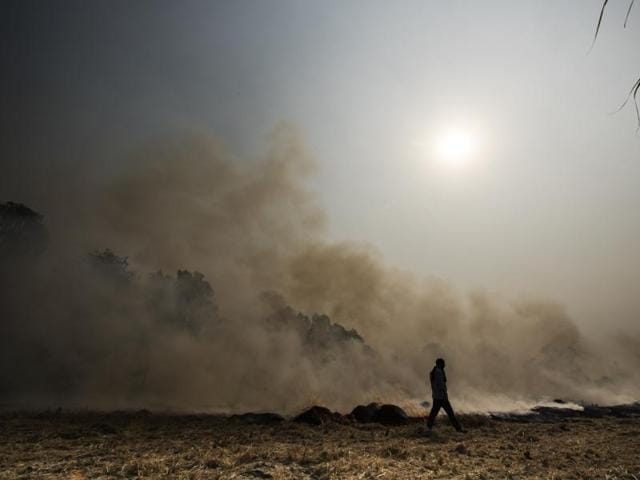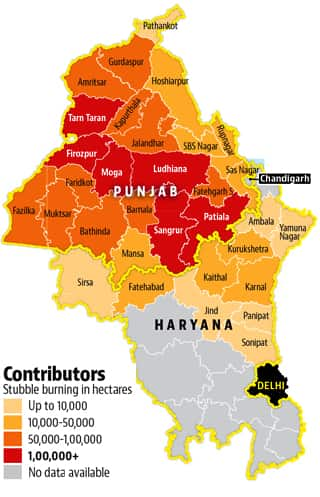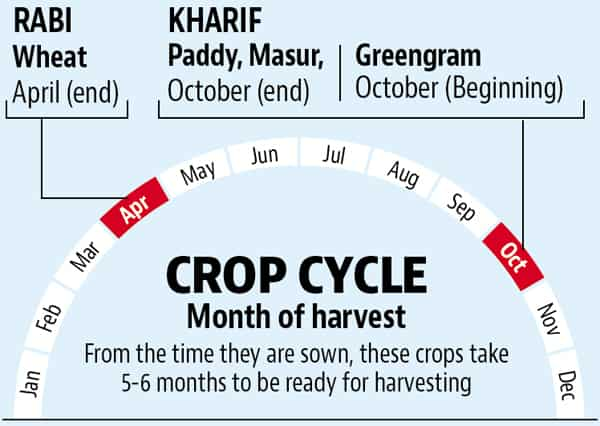Delhi chokes on smoke from neighbouring states
A study by IIT Kanpur listed stubble burning as the third highest contributor to Delhi’s winter air-pollution, after construction dust and vehicular fumes.
Plumes of blinding smoke rise from the fields in Haryana’s Indri village, over 150 kilometres from the National Capital.

Every second farm in the area has been set ablaze as it is the season for stubble burning.
On October 17 and 20, the number of red dots in the ‘fire map’ by NASA grew considerably in Haryana and Punjab.
The ill-effects of these fires are not limited to the two states. They travel to Delhi because of the westerly winds, causing major health concerns among people, say environment experts.
Apart from the lungs, the smoke also affects the brain, eyes and the nervous system, say doctors.
A study by IIT Kanpur listed stubble burning as the third highest contributor to Delhi’s winter air-pollution, after construction dust and vehicular fumes.
Stubble is eight to 10 inches of straw that stands behind after paddy, wheat and other crops have been harvested using a machine. Farmers usually burn the stubble to prepare the fields for the next sowing season.
India produces 550 million tonnes of crop residue every year, with Uttar Pradesh, Punjab and Haryana being the highest producers.
A 2012 study estimated that Punjab and Haryana burnt 80% of rice residue, while Uttar Pradesh burnt 25%.
The Environmental Pollution (Prevention and Control) Authority (EPCA) held a meeting with the Punjab and Haryana governments on Wednesday to discuss the burning issue.
“We have asked the governments to take both coercive and incentive measures to discourage farmers from burning their crop residue. We have suggested that the governments should R100 an acre to farmers to purchase no-till machines,” said EPCA chairperson, Bhure Lal, who headed the meeting.

STUBBLE POLITICS
Despite multiple court orders banning stubble burning and instituting fines, Punjab farmers continue the age-old practice undeterred. The administration of the state, going to polls in 2017, has fined only one offender in October. There have been just eight prosecutions in 2016 so far. In 2015, the figure stood at 16.
There was no major stubble burning during wheat harvesting this year, said PPCB chairman, Manpreet Singh Chhatwal. Paddy harvesting has just begun and figures will come to us after November 15, he said.
“Because of the mounting tension at the Indian-Pakistan border, farmers of seven districts were given free hand to harvest and clear fields. So, the administration didn’t act in some cases,” said Chhatwal.
In comparison, Haryana fined 575 farmers till October 19 and collected Rs 4.12 lakh in fines, Haryana State Pollution Control Board member secretary, S Narayanan, said.
In Kurukshetra district alone, at least 146 offenders were fined in the last two weeks.
Haryana officials say the cases of stubble burning have reduced this year because of heavy prosecutions. Government agencies have also roped in patvaris, gram sachivs and village sarpanchs to reign in the malpractice.
In Haryana, offenders have to pay a fine of Rs 2,500 an acre. In Punjab, violators are liable to a highest fine of Rs 1,000 an acre and a maximum jail term of six months.
Read: Vehicle smoke, road dust add to winter air pollution in Delhi
NO ALTERNATIVES, SAY FARMERS
When HT visited the fields around Haryana’s Kurukshetra, Yamunanagar, Karnal and Panipat districts, many farmers blamed the lack of an alternative for crop residue burning.
They have limited time between crop cycles to ready the land for the next season, they said. By October second week, the farmers of Haryana and Punjab start burning the residue.
In Kurukshetra, Karnal and Panipat, many fields are already covered in black ash, after the burning.
Farmer Sukhwant Singh of Kurukshetra’s Bhore village said most farmers in his village follow a wheat-paddy cycle every year. Burning is the easiest and the cheapest way to prepare the field, he said.
After the fields cool off, most farmers cultivate potato and mustard between cycles to reclaim the soil’s nutrients.
“We don’t know of any other option but to burn the stubble. We have a lot of land and harvesting manually is not possible. When combines (machines) are used for harvesting, the stubble left behind is of no use to us. What do we do with it?” said Singh, who owns six-acre farm.
Machine-generated remains do not mix with the soil. The ash from burning, on the other hand, is good manure for the fields, farmer Mahabir Chand said.

‘IT’S CHEAP, EASY TO BURN WASTE’
Manually harvesting crops doesn’t leave much stubble, said Punjab and Haryana farmers. However, labour is expensive and not easily available.
The labour cost for manual harvesting is Rs 3,000 to Rs 4,000 an acre. On the other hand, renting a combine costs Rs 1,500 to Rs 2,000. It takes just half an hour to harvest an acre of land using a combine.
“We are already running into losses with the low rates for our produce. How can we bear the expenses of the clearance of our fields?” said Satnam Singh Behru, head of a farmer’s group.
BLAME GAME
Kurukshetra district’s deputy commissioner, Sumedha Kataria, refutes farmers’ claims that the ash left behind after stubble burning nourishes the soil.
Apart from health effects and the evening haze bringing the city’s traffic to a standstill, burning kills microbial activity in the soil, she said.
“These farmers think there is no other option but the truth is that there are several better alternatives… The stubble generated can be sold off to paper and cardboard factories and can also be used to generate power,” she said.
Kataria said the administration is educating farmers about the alternatives.
The Punjab Pollution Control Board (PPCB) rubbished charges that state’s stubble burning cause pollution in Delhi.
“We have scientific data of Panipat and Karnal, where air quality remains normal, when smog engulfs Delhi. It is not possible that Punjab’s paddy pollution reaches Delhi bypassing Karnal and Panipat. There must be other reasons, but paddy straw burning is not wholly liable for smog in Delhi,” said PPCB scientific officer, Charanjit Singh.
Delhi’s environment experts did not agree. “Crop burning is a major component of Delhi pollution during winters. This is not only harming Delhi’s residents but the residents of Punjab as well. It is high time the government works hand-in-hand instead of living in denial and indulging in blame game,” said Centre for Science and Environment director, Anumita Roychowdhury.

Every year, farm fires in the surrounding states raise pollutants in the Delhi’s air by over six times the permissible limit, show data. The smoke often rises and swarms over Delhi, especially during winters, when the city is most vulnerable to toxic smog.
Over 25% of particulate matter (PM) 2.5 and 17% of PM10 in Delhi’s winter air is from burning of agriculture waste in the fields around the city, according to the IIT- Kanpur study.
PM2.5 and PM10 are fine particles with diameter less than 2.5 and 10 micrometres, respectively. Permissible limits of PM2.5 and PM10 are 60 and 100 micrograms per cubic metre.
“The Delhi government has been regularly writing to the governments of Haryana and Punjab to control the problem of stubble burning in their states. We want to work with the neighbouring states to control the problem of air pollution,” said Delhi health minister, Satyendar Jain.
The smoke produced by stubble burning contains toxic substances, including PM2.5, carbon monoxide (CO), methane (CH4), carbon dioxide (CO2) and nitrogen oxide (NOx).
A joint study by The Energy and Resources Institute (TERI) and University of California, San Diego, in early October found that over 40% of the PM2.5 in Delhi originates from outside the city. The findings also showed that 60% to 80% of Delhi’s bad ozone, an air pollutant, was from sources outside the city.
By mid-October, the fumes from the blaze travel through the winds to reach Delhi, where the low winter wind speeds makes pollutants settle in the atmosphere.
Read: Delhi haze: When farm fires poison the capital’s air
‘GOVT SHOULD PROMOTE STUBBLE SELLING’
Even if the stubble can be useful as raw material for the cardboard and paper industries, the government has not helped to sell it, said farmers.
“If the government makes some provision to collect the waste, we are even ready to pay them for their services. You cannot just fine farmers without showing them an alternative,” said Indri farmer Balwant Singh.
The residue can also be used to generate power. The Haryana government is planning to set up a power plant in Panipat that will consume the stubble from villages to produce energy for the entire state.
The government also gives a subsidy of Rs 1 lakh to buy New Holand machines, which cut crops with minimum stubble. The Punjab government gives farmers a 50% subsidy on the machine’s cost.
Stay updated with all top Cities including, Bengaluru, Delhi, Mumbai and more across India. Stay informed on the latest happenings in World News along with Delhi Election 2025 and Delhi Election Result 2025 Live, New Delhi Election Result Live, Kalkaji Election Result Live at Hindustan Times.
Stay updated with all top Cities including, Bengaluru, Delhi, Mumbai and more across India. Stay informed on the latest happenings in World News along with Delhi Election 2025 and Delhi Election Result 2025 Live, New Delhi Election Result Live, Kalkaji Election Result Live at Hindustan Times.





